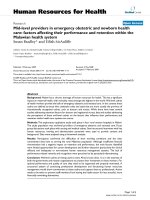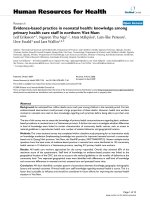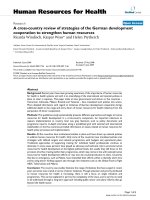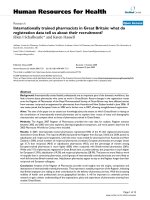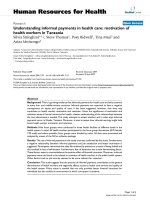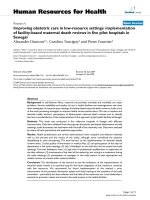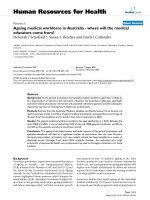báo cáo sinh học:" Ageing medical workforce in Australia - where will the medical educators come from?" ppt
Bạn đang xem bản rút gọn của tài liệu. Xem và tải ngay bản đầy đủ của tài liệu tại đây (232.4 KB, 6 trang )
BioMed Central
Page 1 of 6
(page number not for citation purposes)
Human Resources for Health
Open Access
Research
Ageing medical workforce in Australia - where will the medical
educators come from?
Deborah J Schofield*, Susan L Fletcher and Emily J Callander
Address: Northern Rivers University Department of Rural Health, School of Public Health, Faculty of Medicine, University of Sydney, Syndey,
Australia
Email: Deborah J Schofield* - ; Susan L Fletcher - ;
Emily J Callander -
* Corresponding author
Abstract
Background: As the general practitioner and specialist medical workforce ages there is likely to
be a large number of retirees in the near future. However, few Australian studies have specifically
examined medical practitioner retirement and projected retirement patterns, and the subsequent
impact this may have on training future health care professionals.
Methods: Extracts from the Australian Medicare database and Medical Labour Force Surveys are
used to examine trends in attrition of general medical practitioners and specialists over the age of
45 years from the workforce and to predict their rate of retirement to 2025.
Results: The general medical practitioner workforce has aged significantly (p < 0.05). Between the
years 2000 and 2025, it was projected that 43% of the year 2000 general practitioner workforce
and 56% of the specialist workforce would have retired.
Conclusion: The ageing of the baby boomer and older cohorts of the general practitioner and
specialist workforce will lead to a significant number of retirements over the next 20 years.
Increasing the numbers of students and new medical schools has been heralded as a means of
alleviating service shortages from about 2015 onwards; however, the retirement of a large
proportion of experienced health care professionals may lead to shortages of educators for these
students.
Background
Two major government reports have examined the impact
of ageing in Australia - the Intergenerational Reports
(IGR) released by the Treasury in 2002 and 2007 [1,2] and
the report on the Economic Implications of an Ageing
Australia by the Productivity Commission [3]. These two
reports highlighted future pressures which threaten the
sustainability of the Australian Government budget bal-
ance due to the growing needs of an ageing population
and labour shortages which will limit economic growth
and taxation revenue. In addition, ageing of the 'baby
boomer' generation was found to increase demand for
health care, and consequently the ageing population will
require more health professionals to deliver the services
required in an environment where the existing workforce
is moving rapidly towards retirement.
Numerous studies have noted ageing of the Australian
medical workforce[4-7]. However, there has been very lit-
tle research specifically on general medical practitioner or
Published: 5 November 2009
Human Resources for Health 2009, 7:82 doi:10.1186/1478-4491-7-82
Received: 7 August 2009
Accepted: 5 November 2009
This article is available from: />© 2009 Schofield et al; licensee BioMed Central Ltd.
This is an Open Access article distributed under the terms of the Creative Commons Attribution License ( />),
which permits unrestricted use, distribution, and reproduction in any medium, provided the original work is properly cited.
Human Resources for Health 2009, 7:82 />Page 2 of 6
(page number not for citation purposes)
specilaist retirement or retirement intentions in Australia.
One recent study which examined ageing and rates of
retirement amongst the general practitioner and registered
nursing workforce [8] concluded that there will be a
period of rapid retirement from the medical workforce
over the next 15 years. A recent paper projecting Austral-
ian medical workforce supply from 2001-2012 [9]
included the impact of ageing and concluded that there
will not be enough doctors in 2012. This has contributed
to calls for more medical training places [10] to both meet
the increasing demand for health care caused by the age-
ing Australian population, and to overcome the loss of
medical practitioners as the medical workforce ages. The
government has responded by significantly expanding the
number of medical places available.
This paper will examine ageing of the general medical
practitioner and specialist workforce in Australia and will
project the numbers and timing of their retirement to
2025. The impact that the retirement of experienced
health care professionals has on the training requirements
of the future health care workforce will be discussed.
Methods
The methods used in this paper are similar to those used
recently in Australia to examine past general practitioner
and nursing retirement [8] but using different data sources
and projecting the patterns of retirement into the future.
Grouped data on demographic characteristics (age and
sex) were obtained for general practitioners from the Aus-
tralian Government Department of Health and Ageing's
Medicare data and for specialists (age, sex and hours
worked), from the Australian Institute of Health and Wel-
fare's (AIHW) annual Medical Labour Force Surveys. The
Medicare data was provided from 1984-85 to 2004-05
and the Medical Labour Force Survey data from 1995 to
2003. The census was conducted before 1995, but the def-
initions for specialists have changed substantially so that
comparisons with earlier years are not reliable.
Using Medicare and Medical labour force survey data, 5-
yearly cohorts of general and specialist medical practition-
ers aged 45 years and over were followed from one 5-year
period to the next to calculate attrition rates as general
practitioners and medical specialists left the workforce.
The cohorts were formed by grouping the number of gen-
eral medical practitioners or specialists in the relevant five
year age groups at a base year - e.g. all the specialists aged
between 25 and 29 years in 1995 were grouped together
to form one cohort: the 25-29 year-old specialist cohort.
As each cohort consisted of individuals in a five year age
group (i.e. 45-49, 50-54, 55-59 years and so on) it was
appropriate to calculate attrition of the cohort at 5-yearly
intervals so the number of individuals within the cohort
who progress from one age group to the next could be
determined. Although leaving the workforce may be due
to any of a number of factors including retirement, ill
health, change of profession, and death, attrition in this
paper was broadly grouped as retirement.
Using Medicare and Medical Labour Force Survey data the
net attrition or growth rates (that is, the net numbers
entering or exiting a cohort) were calculated for general
practitioners and specialists every 5 years. This was
expressed as the percentage reduction of growth in total
numbers of the cohort over the previous 5 years. Cumula-
tive net attrition or growth was the sum of the attrition
over all the previous years. The calculation of cumulative
attrition rates was as follows:
where CAR = Cumulative attrition rate,
N = number of people,
ti = time period (where, for example, t1 = the year 2000,
and t2 = the year 2005), and
t1 = first year of data in the series.
Because there were only 9 years of data for specialists,
meaning that attrition could be calculated for the first 5
years and then the next 3 years, the final 2 years of attri-
tion for the second 5 year period was estimated on a pro
rata basis from the attrition of the previous 3 years.
The general and specialist medical practitioner data was
then 'aged' from a base year of 2000, so that it represented
the general and specialist medical practitioner workforce
aged 45 and over in 5, 10, 15, 20 and 25 years time. These
attrition rates were then applied to younger general prac-
titioners and specialists to project future attrition from the
workforce.
A chi-square test of association was undertaken to estab-
lish whether the general medical practitioner and special-
ist workforce had aged significantly between 1985 and
2005. The analyses were undertaken using SAS V9.1 (SAS
Institute Inc., Cary, NC, USA).
Results
The medical workforce in Australia
General medical practitioner numbers and gender 1985-2005
Between 1985 and 2005 the general medical practitioner
workforce in Australia grew from 13 831 to 22 262 general
medical practitioners. General medical practitioners were
predominantly male in all years included in the study,
although their majority decreased steadily from 80% in
CAR N N
ti t
=−1
1
(/)
Human Resources for Health 2009, 7:82 />Page 3 of 6
(page number not for citation purposes)
1985 to 63% in 2005. Women were more highly repre-
sented in the younger age groups, accounting for 26% of
general medical practitioners aged less than 45 in 1985
compared to 12% of general practitioners aged over 45. By
2005, the proportion of women had grown to 49 and
26% in the younger and older age groups respectively.
Specialists numbers and gender 1985-2005
There were about 20 200 specialists in Australia in 1995
increasing to 26 500 by 2003. The majority of specialists
were men in 1995 and this was still the case in 2005.
However, the proportion of female specialists had
increased from 18% to 25%. In the older cohorts, aged 45
years or more, women represented 11% of the specialist
workforce in 1995, but increased to 15% in 2003. How-
ever, they represented a considerably larger proportion of
the younger cohorts, aged less than 45 years, where
women represented 26% of the specialist workforce in
1995 and increased to 34% in 2003.
Ageing of the medical workforce
General medical practitioners
The Australian general practitioner workforce has aged
significantly since 1985 (p < 0.01), with the proportion of
general practitioners aged 45 years and over increasing
from 39% to 64%. Male general practitioners were older
than their female counterparts, with 70% of men and
52% of women aged over 45 in 2005 (43% and 23% in
1985).
Specialists
There has not been marked ageing of the specialist work-
force in Australia between 1995 and 2003. However, with
only nine years of data, gradual ageing over a longer time
period may not be identified. About half of specialists
were aged 45 and over in both 1995 and 2003.
Projected retirement of older general practitioners and
specialists
General medical practitioners
The attrition rates calculated for general practitioners aged
45 and over were used to project future general medical
practitioner retirements from 2005 to 2025. These were
based upon the attrition rates of general practitioners and
specialists observed between 1985-2005 and 1995-2005
respectively (as shown in Table 1 and Table 2)
In the year 2000, there were 21 355 general medical prac-
titioners in Australia. Of these, 1289 or 6% were projected
to retire by 2005 (Figure 1). A further 5% were expected to
retire in the five years to 2010. A greater number of general
medical practitioners were expected to leave the workforce
in each subsequent five year period so that by 2025, a total
of 9280 or 43% of the 2000 workforce would no longer
be practicing (Figure 2). The acceleration of retiree num-
bers is caused by the large group of younger general prac-
titioners in their forties, with the largest group who would
reach the age of 65 years in about 20 years time totalling
almost 4000 in the 45 to 49 age group.
Specialists
Of the specialists who were aged 45 to 49 years in 2005,
39% were projected to cease practicing by 2020 when they
were aged 65 to 69 years, with this figure increasing to
64% when they would be 70 to 74 years of age. As with
general practitioners, there were some specialists practic-
ing at 80 years of age or more. However as the numbers
were too small for reliable projections, it was assumed
that all specialists retired after 80 years of age.
Table 1: Cumulative attrition from the general physician
workforce 1985-2005, Australia
45-49 50-54 55-59 60-64 65-69 70-74 75-79
1985
1990 0% 1% 2% 10% 23% 39% 20%
1995 0% 6% 15% 32% 49% 63%
2000 2% 21% 40% 59% 72%
2005 20 48% 67% 78%
Age groups can be followed down the columns of the table. For
example, 10% of the GPs aged 60-64 years in 1985 had left the
workforce by 1990, when they were aged 65-69.
Source: Australian Government Department of Health and Ageing
Medicare data, 1985 to 2005. Calculation of cumulative attrition rates
for each cohort: CAR = 1-(Nti/Nt1) where CAR = Cumulative
attrition rate, N = number of people, ti = year in series and t1 = first
data year in series (1985).
Table 2: Cumulative attrition from the specialist workforce
1995-2005, Australia
45-49 50-54 55-59 60-64 65-69 70-74 75-79
1995
2000 2% 2% 11% 28% 41% 39% 60%
2005* 5% 1% 54% 71% 76% 100%
*Data for 2004 and 2005 were based on projections assuming the
same rate of attrition for the previous 3 years 2001-2003
Age groups can be followed down the columns of the table. For
example, 2% of specialists aged 45-49 years in 1995 had left the
workforce by the year 2000, when they were aged 50-54.
Source: AIHW Medical Labour Force Survey, 1995 to 2003.
Calculation of cumulative attrition rates for each cohort: CAR = 1-
(Nti/Nt1) where CAR = Cumulative attrition rate, N = number of
people, ti = year in series and t1 = first data year in series (1995).
Calculation of attrition from 2000 to 2005 = CAR
2000-2003
*1 2/3.
Human Resources for Health 2009, 7:82 />Page 4 of 6
(page number not for citation purposes)
Of the approximately 23 300 specialist medical practi-
tioners in the year 2000, about 1655 were projected to
retire over the five years to 2005 (Figure 1). A further 3410
were projected to retire in the following five years to 2010,
and between 1700 and 2600 every five years after that to
2025. This amounted to a total of 11 722 retirees or 50%
of the specialist workforce in the year 2000 (Figure 2). The
large number of retirees between 2005 and 2010 reflects
the combination of rapid retirement in the 55-69 year age
group, which is also shown in the medical labour force
historical survey data, (see Table 1) and the large size of
the cohort entering these age groups in the second five
year period.
Future medical education workforce
A medical educator, also known as a teacher/educator, is
defined by the Australian Institute of Health and Welfare
as "a person teaching or training persons in medicine".
The average age of medical educators in 2005 was 50.9
years [11]. This is slightly older than the average age of
general medical practitioners and specialists, which in
2005 was 48.6 years and 49.9 years. In twenty years time
there will be fewer general medical practitioners in the
higher age groups from which medical educators gener-
ally belong.
Based upon contemporary numbers of general medical
practitioners and specialists, and the growth and subse-
quent attrition trends of the current medical workforce,
some estimates of future workforce numbers in the age
groups typical of medical educators can be made. The
numbers in the cohort of general medical practitioners
who were aged 25-34 in 2005 will increase from the 1161
who are currently in the workforce. In 2025, this cohort
will be aged 45-54 and there will be approximately 3340
general practitioners in this age group. This is less than the
number of general medical practitioners who were in
these age groups in 2005.
The number of specialists in these older age groups could
not be projected as far, due to the limited data available.
However, it was estimated that in 2013, there will be
approximately 8430 specialists in the 45-54 age group,
based upon the projected changes to the cohort aged 35-
44 years in 2003. This is more than the numbers in this
age group in 2003.
Discussion
The results of this study show that 43% of general medical
practitioners and 50% of specialists that were practicing in
2000 will likely have retired by 2025. This represents the
loss of a large proportion of the accumulated experience
in the general partitioner and specialist health care profes-
sional workforce. This upcoming retirement of a large pro-
portion of the experienced general practitioner and
specialist workforce may lead to difficulties in meeting the
need for an increasing number of future educators, as
many of those who have the experience necessary to edu-
cate them will have retired.
The ageing of the medical workforce which has been well
documented in other studies, is posing numerous work-
force planning issues [6,8,12,13]. Training more health
care professionals has been seen as one way of overcom-
ing future health workforce shortages potentially caused
by this ageing workforce. In 2006, $250 million (Austral-
ian dollars throughout) was pledged to be spent on doctor
and nurse training to 2010 [10]. There has also been an
Projected retirement every five years, general medical practi-tioners and specialists aged 45 years or more, 2000-2025, AustraliaFigure 1
Projected retirement every five years, general medi-
cal practitioners and specialists aged 45 years or
more, 2000-2025, Australia.
Projected cumulative retirement every five years, general medical practitioners and specialists aged 45 years or more, 2000-2025, AustraliaFigure 2
Projected cumulative retirement every five years,
general medical practitioners and specialists aged 45
years or more, 2000-2025, Australia.
Human Resources for Health 2009, 7:82 />Page 5 of 6
(page number not for citation purposes)
associated recent increase in the number of training places
available, and these new students should begin to fill the
800 to 1300 general practitioner shortages identified by
the Australian government in 2005, and at least some of
the cohort of retiring practitioners [14]. However, there
may be a shortage of experienced general medical practi-
tioners to provide the post graduate training as a large
number of experienced workers retires, as demonstrated
by this study.
The average age of medical professionals who act as med-
ical educators in 2005 was 50.9 years [11]. This is slightly
older than the average age of all general medical practi-
tioners and specialists, which in 2005 was 48.6 years and
49.9 years respectively. It should be noted that some indi-
viduals may also practice while also acting as medical edu-
cators. In twenty years time (from 2005), there will be
fewer general medical practitioners and specialists in the
older age groups from which medical educators generally
belong. The results of this study indicate that by 2020,
78% of general practitioners aged 45-49 in 2005, and
93% of specialists aged 45-49 in 2005 will have retired
from the workforce. This will likely leave a significant
shortfall in the experienced health care professionals
available to train the larger future health workforce.
It is likely that there will continue to be fewer general
medical practitioners acting as medical educators in the
future due to the lower pool from which these general
medical practitioner educators may be drawn, assuming
most of them come from the 45-54 year old age group, as
reflected in the mean age of medical educators. The num-
bers which will be in this age group in 2025 is less than
the numbers for this age group in 2005. The number of
specialists acting as medical educators is likely to remain
unchanged or even increase due to the increasing number
of specialists entering this age bracket in the future.
This has been noted by the National Health Workforce
Taskforce who identified that there is a "lack of capacity to
provide training" for future health care professionals [15].
It also predicted that there would be increasing pressure to
place students in training positions in the future as current
experienced health care teachers retired.
Furthermore, the lower numbers currently entering the
general practitioner workforce will exacerbate the short-
age of experienced professionals within this discipline. In
2025, there are expected to be fewer general practitioners
in the older age groups than there are at present. Deferring
the retirement of these older general practitioners, in
order to extend the period of time for which their experi-
ence can be utilised in both practice and education, is
unlikely to be an option. Their retirement patterns are
already characterised by gradual retirement and working
beyond the traditional retirement age [8]. The majority of
general practitioners and specialists retire over the age of
60, which is much older than the average retirement age
for the Australian population of 52 years [16].
Based upon these projections, it seems that there will be a
decreased number of experienced general medical practi-
tioners in future years, which will create difficulties in pro-
viding education to incoming medical professionals.
However, these projections are based upon the assump-
tion that retirement patterns will remain the same as cur-
rent ones into the future, which can be seen as a limitation
of this study. With feminisation of the medical workforce,
it is possible that retirement may in the future be some-
what earlier [17].
Conclusion
Ageing and retirement of the baby boomer and older
cohorts of the general medical practitioner and specialist
workforce, combined with an ageing population demand-
ing more services, are likely to add to shortages over the
next 20 years. Increasing numbers of students and new
medical schools has been heralded as a means of alleviat-
ing shortages from about 2015 onwards; however, the
retirement of a large proportion of experienced health
care professionals may lead to shortages of educators of
these students.
Competing interests
The authors declare that they have no competing interests.
Authors' contributions
DS conceived of the study and participated in the drafting
and editing of the manuscript, data analysis and interpre-
tation of the findings. SF participated in the drafting and
editing of the manuscript, data analysis and interpretation
of the findings. EC participated in the drafting and editing
of the manuscript, and interpretation of the findings. All
authors read and approved the final manuscript.
Acknowledgements
None.
References
1. Commonwealth of Australia: Intergenerational Report 2002-03.
Canberra: Department of The Treasury; 2002.
2. Costello P: Intergenerational report 2007. Canberra: Common-
wealth of Australia; 2007.
3. Productivity Commission: Economic implications of an ageing
Australia. Canberra: Productivity Commission; 2005.
4. Australian Institute of Health and Welfare: Medical labour force
2002. Canberra: AIHW; 2004.
5. Australian Institute of Health and Welfare: Nursing labour force
2001. Canberra: AIHW; 2003.
6. Australian Medical Workforce Advisory Committee: Australian
Medical Workforce Advisory Committee Annual Report
2003-04. Sydney: AMWAC; 2004.
7. Australian Health Workforce Advisory Committee: Australian
Health Workforce Advisory Committee 2004 Annual
Report. Sydney: AHWAC; 2004.
Publish with Bio Med Central and every
scientist can read your work free of charge
"BioMed Central will be the most significant development for
disseminating the results of biomedical research in our lifetime."
Sir Paul Nurse, Cancer Research UK
Your research papers will be:
available free of charge to the entire biomedical community
peer reviewed and published immediately upon acceptance
cited in PubMed and archived on PubMed Central
yours — you keep the copyright
Submit your manuscript here:
/>BioMedcentral
Human Resources for Health 2009, 7:82 />Page 6 of 6
(page number not for citation purposes)
8. Schofield DJ, Beard JR: Baby boomer doctors and nurses: demo-
graphic change and transitions to retirement. Medical Journal
of Australia 2005, 184:80-83.
9. Joyce CM, McNeil JJ, Stoelwinder JU: More doctors, but not
enough: Australian medical workforce supply 2001-2012.
Medical Journal of Australia 2006, 184:441-446.
10. ABC News: States say more medical training places needed.
ABC Online 2006 [ />1611889.htm].
11. Australian Institute of Health and Welfare: Medical labour force
2005. Canberra: AIHW; 2008.
12. Australian Institute of Health and Welfare: Medical labour force
2002. In National Health Labour Force Series No 30 Canberra: AIHW;
2004.
13. Australian Institute of Health and Welfare: Medical labour force
2004. Canberra: AIHW; 2006.
14. Australian Medical Workforce Advisory Committee: The general
practice workforce in Australia: supply and requirements to
2013. Sydney: AMWAC; 2005.
15. National Health Workforce Taskforce: Data, capacity and clinical
placements across Australia: a discussion paper. Melbourne:
National Health Workforce Taskforce; 2008.
16. Australian Bureau of Statistics: Retirement and Retirement
Intentions, Australia, Jul 2006 to Jun 2007. Canberra: ABS;
2008.
17. Australian Bureau of Statistics: Retirement and retirement
intentions. Canberra: Australian Bureau of Statistics; 1997.


